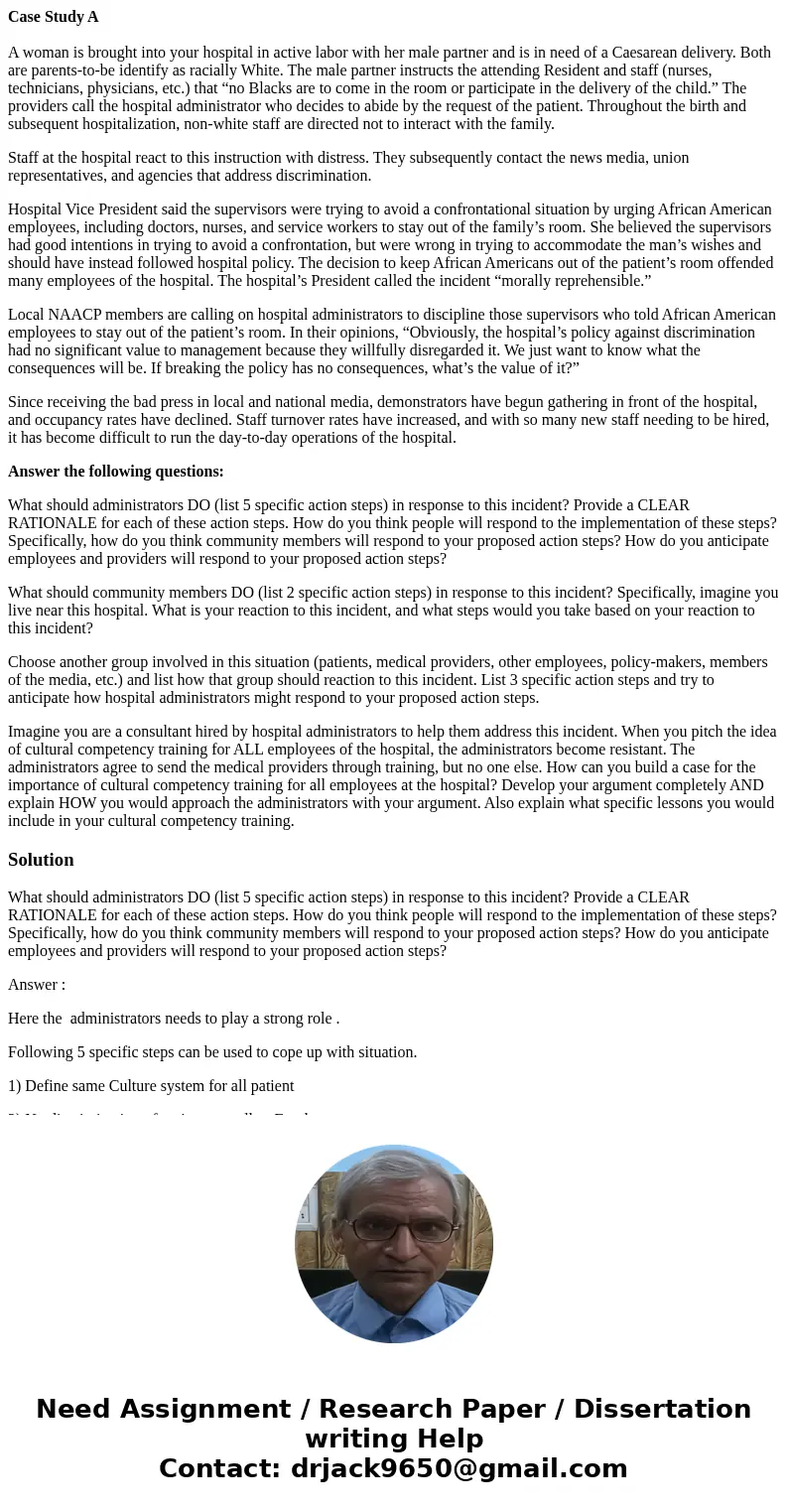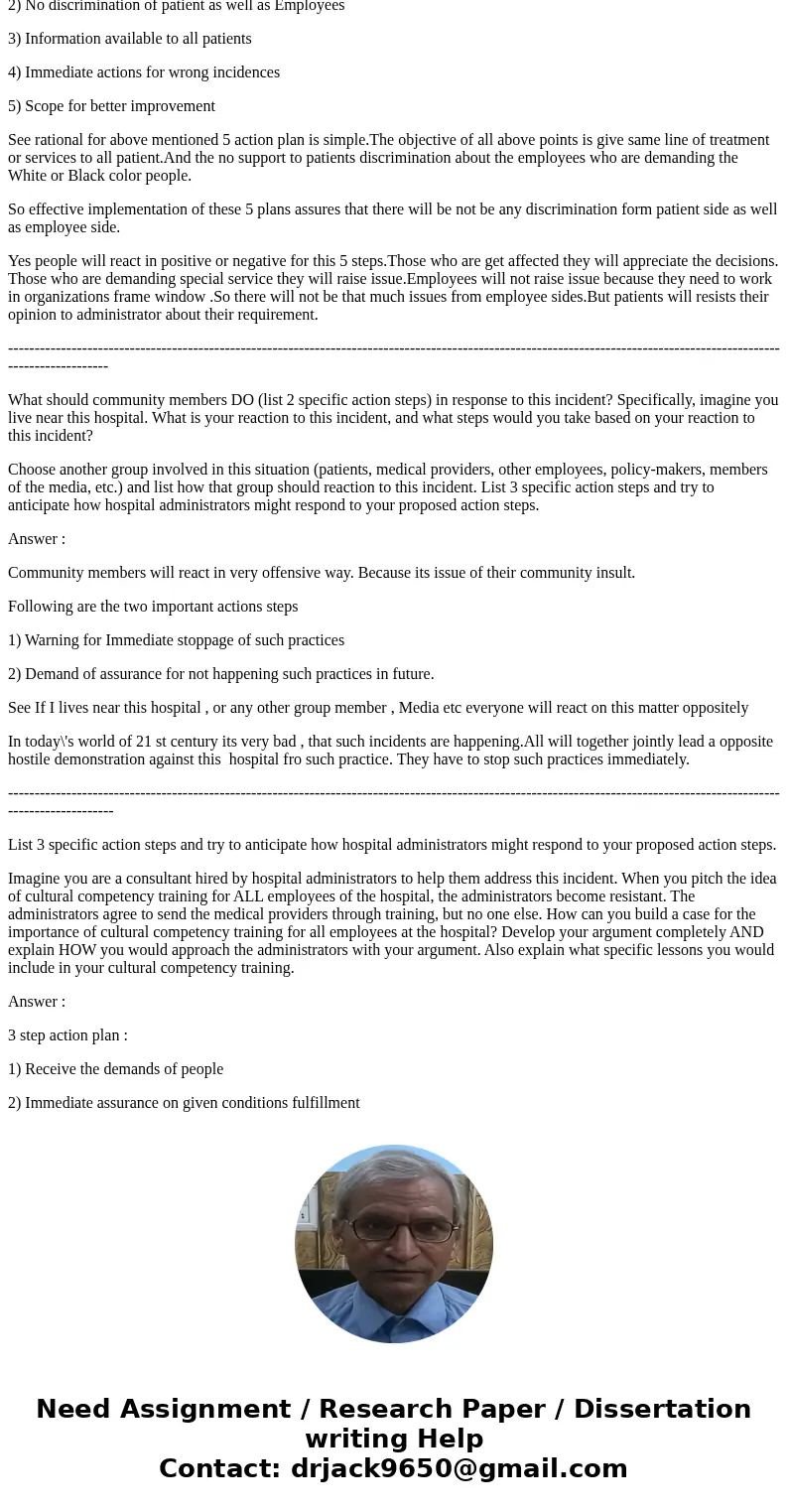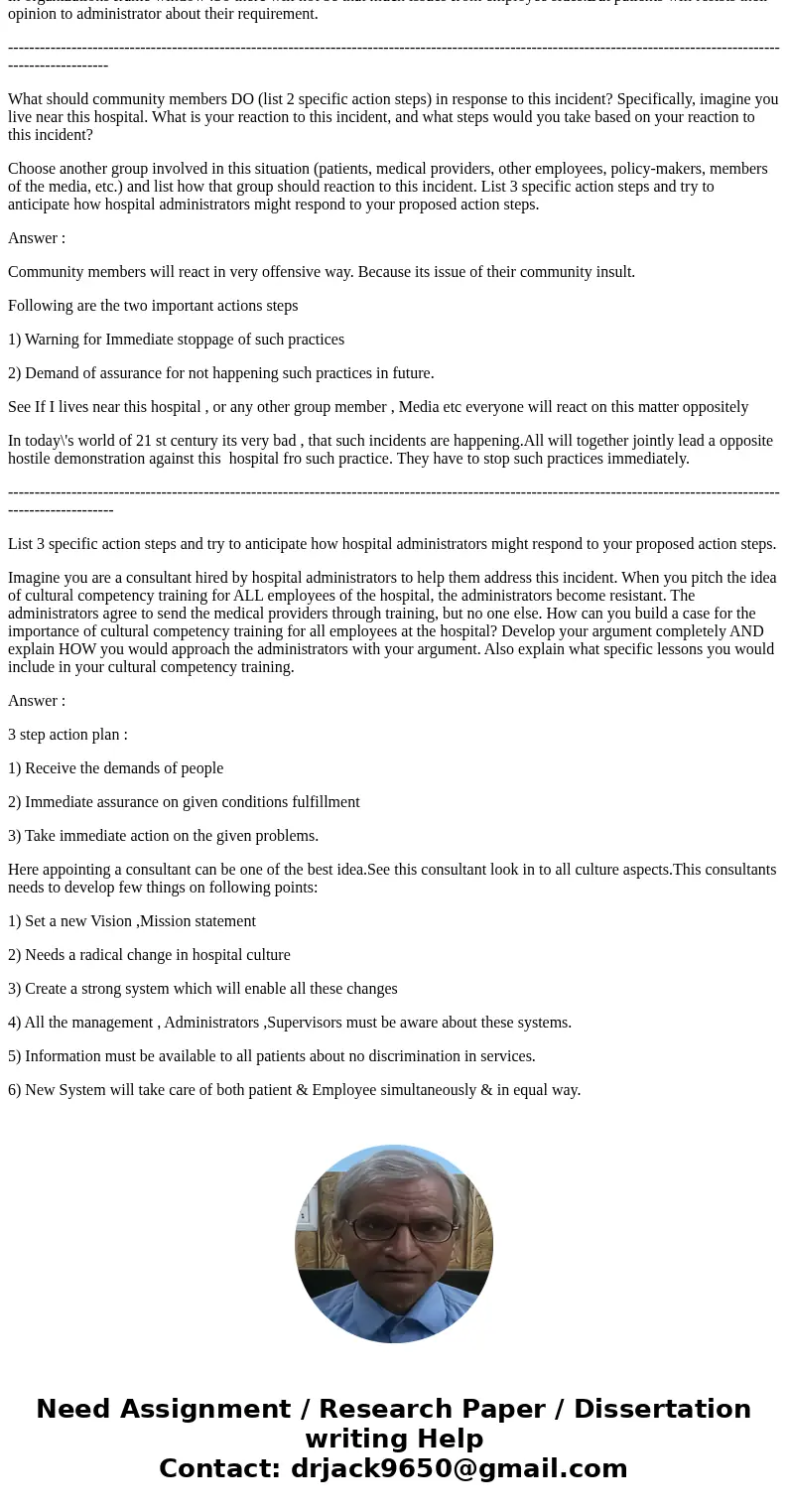Case Study A A woman is brought into your hospital in active
Case Study A
A woman is brought into your hospital in active labor with her male partner and is in need of a Caesarean delivery. Both are parents-to-be identify as racially White. The male partner instructs the attending Resident and staff (nurses, technicians, physicians, etc.) that “no Blacks are to come in the room or participate in the delivery of the child.” The providers call the hospital administrator who decides to abide by the request of the patient. Throughout the birth and subsequent hospitalization, non-white staff are directed not to interact with the family.
Staff at the hospital react to this instruction with distress. They subsequently contact the news media, union representatives, and agencies that address discrimination.
Hospital Vice President said the supervisors were trying to avoid a confrontational situation by urging African American employees, including doctors, nurses, and service workers to stay out of the family’s room. She believed the supervisors had good intentions in trying to avoid a confrontation, but were wrong in trying to accommodate the man’s wishes and should have instead followed hospital policy. The decision to keep African Americans out of the patient’s room offended many employees of the hospital. The hospital’s President called the incident “morally reprehensible.”
Local NAACP members are calling on hospital administrators to discipline those supervisors who told African American employees to stay out of the patient’s room. In their opinions, “Obviously, the hospital’s policy against discrimination had no significant value to management because they willfully disregarded it. We just want to know what the consequences will be. If breaking the policy has no consequences, what’s the value of it?”
Since receiving the bad press in local and national media, demonstrators have begun gathering in front of the hospital, and occupancy rates have declined. Staff turnover rates have increased, and with so many new staff needing to be hired, it has become difficult to run the day-to-day operations of the hospital.
Answer the following questions:
What should administrators DO (list 5 specific action steps) in response to this incident? Provide a CLEAR RATIONALE for each of these action steps. How do you think people will respond to the implementation of these steps? Specifically, how do you think community members will respond to your proposed action steps? How do you anticipate employees and providers will respond to your proposed action steps?
What should community members DO (list 2 specific action steps) in response to this incident? Specifically, imagine you live near this hospital. What is your reaction to this incident, and what steps would you take based on your reaction to this incident?
Choose another group involved in this situation (patients, medical providers, other employees, policy-makers, members of the media, etc.) and list how that group should reaction to this incident. List 3 specific action steps and try to anticipate how hospital administrators might respond to your proposed action steps.
Imagine you are a consultant hired by hospital administrators to help them address this incident. When you pitch the idea of cultural competency training for ALL employees of the hospital, the administrators become resistant. The administrators agree to send the medical providers through training, but no one else. How can you build a case for the importance of cultural competency training for all employees at the hospital? Develop your argument completely AND explain HOW you would approach the administrators with your argument. Also explain what specific lessons you would include in your cultural competency training.
Solution
What should administrators DO (list 5 specific action steps) in response to this incident? Provide a CLEAR RATIONALE for each of these action steps. How do you think people will respond to the implementation of these steps? Specifically, how do you think community members will respond to your proposed action steps? How do you anticipate employees and providers will respond to your proposed action steps?
Answer :
Here the administrators needs to play a strong role .
Following 5 specific steps can be used to cope up with situation.
1) Define same Culture system for all patient
2) No discrimination of patient as well as Employees
3) Information available to all patients
4) Immediate actions for wrong incidences
5) Scope for better improvement
See rational for above mentioned 5 action plan is simple.The objective of all above points is give same line of treatment or services to all patient.And the no support to patients discrimination about the employees who are demanding the White or Black color people.
So effective implementation of these 5 plans assures that there will be not be any discrimination form patient side as well as employee side.
Yes people will react in positive or negative for this 5 steps.Those who are get affected they will appreciate the decisions. Those who are demanding special service they will raise issue.Employees will not raise issue because they need to work in organizations frame window .So there will not be that much issues from employee sides.But patients will resists their opinion to administrator about their requirement.
---------------------------------------------------------------------------------------------------------------------------------------------------------------------
What should community members DO (list 2 specific action steps) in response to this incident? Specifically, imagine you live near this hospital. What is your reaction to this incident, and what steps would you take based on your reaction to this incident?
Choose another group involved in this situation (patients, medical providers, other employees, policy-makers, members of the media, etc.) and list how that group should reaction to this incident. List 3 specific action steps and try to anticipate how hospital administrators might respond to your proposed action steps.
Answer :
Community members will react in very offensive way. Because its issue of their community insult.
Following are the two important actions steps
1) Warning for Immediate stoppage of such practices
2) Demand of assurance for not happening such practices in future.
See If I lives near this hospital , or any other group member , Media etc everyone will react on this matter oppositely
In today\'s world of 21 st century its very bad , that such incidents are happening.All will together jointly lead a opposite hostile demonstration against this hospital fro such practice. They have to stop such practices immediately.
----------------------------------------------------------------------------------------------------------------------------------------------------------------------
List 3 specific action steps and try to anticipate how hospital administrators might respond to your proposed action steps.
Imagine you are a consultant hired by hospital administrators to help them address this incident. When you pitch the idea of cultural competency training for ALL employees of the hospital, the administrators become resistant. The administrators agree to send the medical providers through training, but no one else. How can you build a case for the importance of cultural competency training for all employees at the hospital? Develop your argument completely AND explain HOW you would approach the administrators with your argument. Also explain what specific lessons you would include in your cultural competency training.
Answer :
3 step action plan :
1) Receive the demands of people
2) Immediate assurance on given conditions fulfillment
3) Take immediate action on the given problems.
Here appointing a consultant can be one of the best idea.See this consultant look in to all culture aspects.This consultants needs to develop few things on following points:
1) Set a new Vision ,Mission statement
2) Needs a radical change in hospital culture
3) Create a strong system which will enable all these changes
4) All the management , Administrators ,Supervisors must be aware about these systems.
5) Information must be available to all patients about no discrimination in services.
6) New System will take care of both patient & Employee simultaneously & in equal way.



 Homework Sourse
Homework Sourse